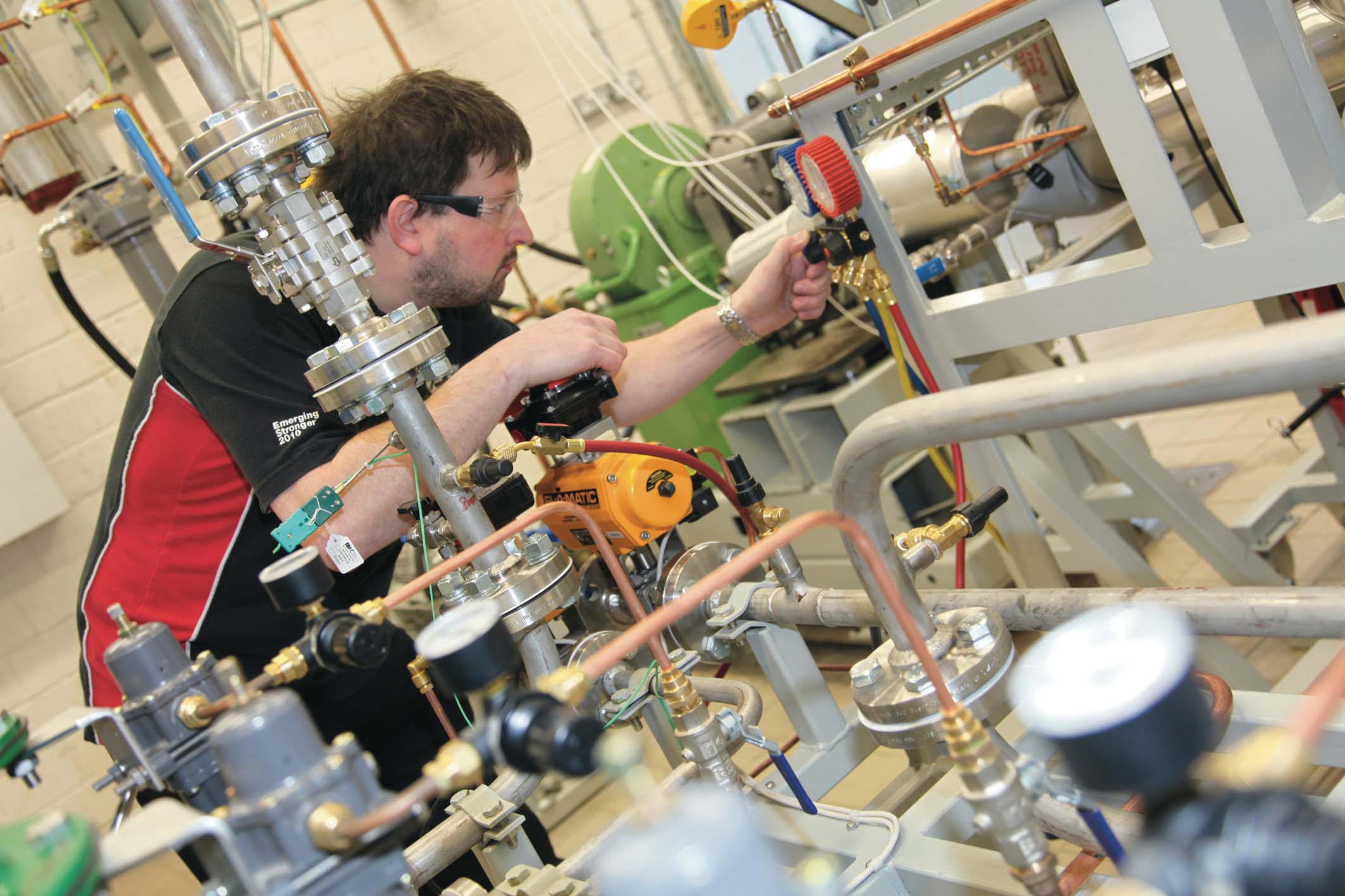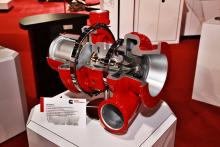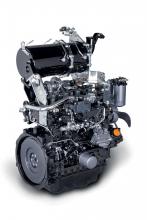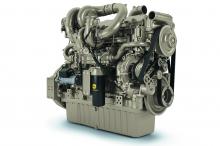Cummins develops new turbo technology to boost diesel efficiency and performance – Geoff Ashcroft reports
Cummins Turbo Technologies (CTT), a global engineering leader in turbocharger technology, has revealed a new range of large turbochargers for engine capacities of 16litres and above. Called the 900 series, the new turbo platform sits between the 800 and 1000 series models and is said to provide robust, flexible solutions for the off-highway sectors, including quarrying and mining applications.
Des

Testing waste heat recovery systems at CTT’s test cells
Cummins develops new turbo technology to boost diesel efficiency and performance – Geoff Ashcroft reports
196 Cummins Turbo Technologies (CTT), a global engineering leader in turbocharger technology, has revealed a new range of large turbochargers for engine capacities of 16litres and above. Called the 900 series, the new turbo platform sits between the 800 and 1000 series models and is said to provide robust, flexible solutions for the off-highway sectors, including quarrying and mining applications.
Designed to meet the diverse duty cycles of engines from 16-120litres, the 900 series draws on CTT’s 30 years of experience in developing and manufacturing turbochargers for the high-speed diesel engine market. As a result, the complete turbocharger range is suitable for applications from 294-4,707kW. The 900 series turbocharger is suitable for both diesel and natural gas applications from 1,500-4,800kW. It will also be used on the 95litre Cummins QSK95 to achieve Tier 4 emissions requirements.
Jonathan Wood, CTT’s executive director of research and engineering, said the firm has developed the most efficient turbochargers in this range which, complete with new technologies, are capable of improving overall turbocharger efficiency of a typical application by up to 10%. “With the 900 series, we have focussed on efficiency and as a result, have totally redesigned impellor and turbine profiles to deliver up to 10% more efficiency through better air flow,” he said.
Changes to the intake have enabled CTT to install what it calls a bespoke Super Map Width Enhancement ahead of the impellor. Such a design is said to prevent surge and it will also lower working noise levels. “In certain applications, we would expect the higher efficiency of the 900 series to enable one turbocharger to replace a two-stage turbocharger installation,” he said. “This will simplify packaging issues for OEMs, without compromising on performance. It does have a high pressure capability.”
The modular build of the 900 series has resulted in both the compressor and exhaust housings mounted on V-clamps, giving 360o rotation of housings to simplify plumbing of pipework. The wide, central core and bearing housing also enables the turbocharger to be pedestal mounted. “A pedestal mounting will take pressure off the turbine housing, which is where most turbochargers are mounted to their engines,” he said. “This will avoid stress cracks and failures with manifolds.”
The bearing housing is water-cooled and gets an integrated speed sensor to monitor turbocharger speeds via the engine’s ECM, offering additional diagnostic potential and engine protection. Bearings are lead-free and corrosion-resistant, suiting applications operating on landfill gas where fuel corrosion remains a difficult challenge to overcome.
From its UK base, CTT operates 18 turbocharger test cells and six engine test cells, where it can, literally, test to destruction. Typically, six-second cycles, from idle to full speed and back, for over 200,000 cycles form the basis of a starting point when establishing durability. Over 15,000 tests are carried out each year.
With flows, pressures and temperatures all monitored and constantly varied – 200-850°C simulation is achievable in the test cells – bespoke operating maps are produced for every turbocharged series produced. On one bench, an HX82 turbocharger had been dismantled and was undergoing inspection after clocking up in excess of 30,000hours of constant use on a QSK60-powered genset that had been running for four years. The unit had never failed, was only blackened and had suffered light vane damage on the exhaust turbine.
The company also tests competitive products too, bought on the aftermarket, so it knows what it is up against. Cummins Turbo Technologies also unveiled plans for investment in future technology solutions for the range to improve fuel efficiency. The shift in focus to prioritise fuel economy highlights CTT’s belief that the industry has now reached the tipping-point at which global engine and equipment manufacturers are developing products designed to insulate customers from rising fuel prices.
“Our close working relationship with customers always informs the focus of our research and development,” said Mark Firth, executive director for product line management and marketing. “This relationship has shaped not just these developments which we showcased at Conexpo, but also the further extensions to the range that we have planned.”
A tour of the test cells revealed that the company is currently working on a prototype waste heat recovery system that has the potential to deliver a 5-6% fuel efficiency gain on 13litre 373kW engines. Using a turbine expander, the firm is experimenting with harnessing waste heat from turbochargers, engine coolers and exhaust systems to power a secondary turbine that can feed power back into components.
Expected to generate around 25kW of power, the waste heat recovery system clearly has massive potential. It could be used to power hybrid electrical systems or hydraulic pumps, for example. Still at an early development stage, the likely widespread adoption of waste heat recovery from CTT could be as soon as 2018, once the efficiency of couplings has been fully exploited. “Our competitive, market-proven products and technologies draw on our heritage of innovation and engineering excellence and will continue to deliver savings to our customers without ever compromising on performance,” said Firth.
Cummins Turbo Technologies produces 2.2m turbochargers each year, half of which go to Cummins engines and the remainder are for OEM use with customers that include718 Liebherr, 2394 Volvo, 236 Hyundai, 2300 Komatsu and 695 Doosan. CTT is part of the Cummins Components Group, which in turn is part of Cummins INC, the world’s largest independent maker of diesel engines and related products. In 1973, Cummins INC bought Huddersfield-based Holset Engineering, changing its name to Cummins Turbo Technologies in 2006. For over 60 years, the Holset name has been synonymous with turbocharging and air handling, and is still retained as the product brand.
Designed to meet the diverse duty cycles of engines from 16-120litres, the 900 series draws on CTT’s 30 years of experience in developing and manufacturing turbochargers for the high-speed diesel engine market. As a result, the complete turbocharger range is suitable for applications from 294-4,707kW. The 900 series turbocharger is suitable for both diesel and natural gas applications from 1,500-4,800kW. It will also be used on the 95litre Cummins QSK95 to achieve Tier 4 emissions requirements.
Jonathan Wood, CTT’s executive director of research and engineering, said the firm has developed the most efficient turbochargers in this range which, complete with new technologies, are capable of improving overall turbocharger efficiency of a typical application by up to 10%. “With the 900 series, we have focussed on efficiency and as a result, have totally redesigned impellor and turbine profiles to deliver up to 10% more efficiency through better air flow,” he said.
Changes to the intake have enabled CTT to install what it calls a bespoke Super Map Width Enhancement ahead of the impellor. Such a design is said to prevent surge and it will also lower working noise levels. “In certain applications, we would expect the higher efficiency of the 900 series to enable one turbocharger to replace a two-stage turbocharger installation,” he said. “This will simplify packaging issues for OEMs, without compromising on performance. It does have a high pressure capability.”
The modular build of the 900 series has resulted in both the compressor and exhaust housings mounted on V-clamps, giving 360o rotation of housings to simplify plumbing of pipework. The wide, central core and bearing housing also enables the turbocharger to be pedestal mounted. “A pedestal mounting will take pressure off the turbine housing, which is where most turbochargers are mounted to their engines,” he said. “This will avoid stress cracks and failures with manifolds.”
The bearing housing is water-cooled and gets an integrated speed sensor to monitor turbocharger speeds via the engine’s ECM, offering additional diagnostic potential and engine protection. Bearings are lead-free and corrosion-resistant, suiting applications operating on landfill gas where fuel corrosion remains a difficult challenge to overcome.
From its UK base, CTT operates 18 turbocharger test cells and six engine test cells, where it can, literally, test to destruction. Typically, six-second cycles, from idle to full speed and back, for over 200,000 cycles form the basis of a starting point when establishing durability. Over 15,000 tests are carried out each year.
With flows, pressures and temperatures all monitored and constantly varied – 200-850°C simulation is achievable in the test cells – bespoke operating maps are produced for every turbocharged series produced. On one bench, an HX82 turbocharger had been dismantled and was undergoing inspection after clocking up in excess of 30,000hours of constant use on a QSK60-powered genset that had been running for four years. The unit had never failed, was only blackened and had suffered light vane damage on the exhaust turbine.
The company also tests competitive products too, bought on the aftermarket, so it knows what it is up against. Cummins Turbo Technologies also unveiled plans for investment in future technology solutions for the range to improve fuel efficiency. The shift in focus to prioritise fuel economy highlights CTT’s belief that the industry has now reached the tipping-point at which global engine and equipment manufacturers are developing products designed to insulate customers from rising fuel prices.
“Our close working relationship with customers always informs the focus of our research and development,” said Mark Firth, executive director for product line management and marketing. “This relationship has shaped not just these developments which we showcased at Conexpo, but also the further extensions to the range that we have planned.”
A tour of the test cells revealed that the company is currently working on a prototype waste heat recovery system that has the potential to deliver a 5-6% fuel efficiency gain on 13litre 373kW engines. Using a turbine expander, the firm is experimenting with harnessing waste heat from turbochargers, engine coolers and exhaust systems to power a secondary turbine that can feed power back into components.
Expected to generate around 25kW of power, the waste heat recovery system clearly has massive potential. It could be used to power hybrid electrical systems or hydraulic pumps, for example. Still at an early development stage, the likely widespread adoption of waste heat recovery from CTT could be as soon as 2018, once the efficiency of couplings has been fully exploited. “Our competitive, market-proven products and technologies draw on our heritage of innovation and engineering excellence and will continue to deliver savings to our customers without ever compromising on performance,” said Firth.
Cummins Turbo Technologies produces 2.2m turbochargers each year, half of which go to Cummins engines and the remainder are for OEM use with customers that include







